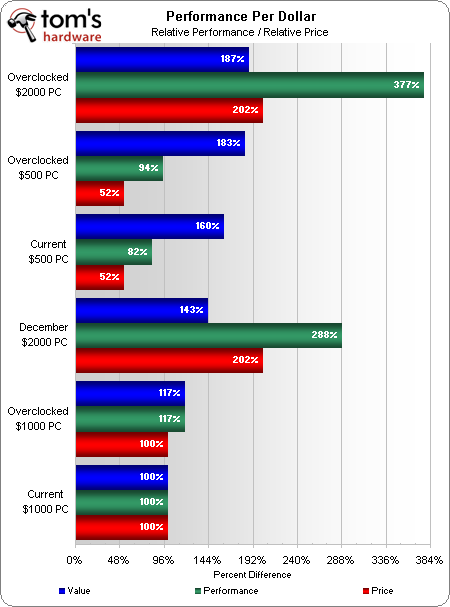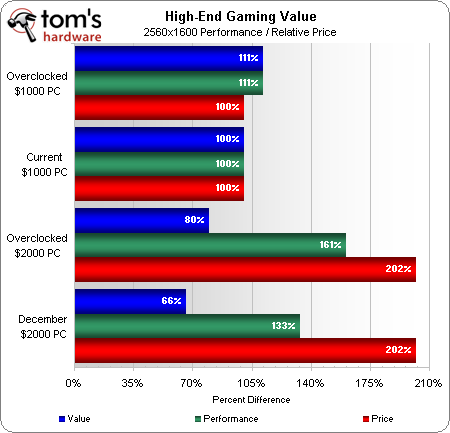System Builder Marathon, December 2010: Value, Compared
New benchmarks, new test methods, and new hardware mark exciting updates to this month’s System Builder Marathon. Today, we cover the most exciting part of all: the value competition. Remember, we're giving all three systems away, so enter to win them!
Value Conclusion
While all of this month’s systems performed admirably in our traditional benchmark suite, adding hard drive test to our average performance score threw the summary charts into a completely different direction. Accounting for a mere ¼ of the benchmark average, an enormous 894% hard drive performance lead for the SSD-equipped $2000 PC nearly doubles its performance rating. Will that be enough to overtake the $500 system in value?
Including drive performance in today’s performance charts allowed the $2000 PC to win by a landslide. Readers who don’t place much emphasis on hard drive performance (including program launch time and Windows startup) will like to know that dropping that data from our performance average would have dropped the overclocked $2000 system’s performance rating to 202%, resulting in a value rating of only 101%. On the other hand, $220 of that system’s total budget was spent on those SSDs, and using the remaining “storage drive” as a system drive would have boosted the lower value rating from 101% to 114%. Similar money could have been saved on the $2000 system by using a mid-market case, CPU fan, and optical drive, and that looks like a better deal to us.
Any $500 build is sure to suffer at the hands of an SSD-equipped machine, so long as drive performance makes up ¼ of our overall performance score. A $1000 budget could have opened up a few low-capacity SSD options, but benchmarking drives that are too small to qualify as system drives would have been a form of cheating (Ed.: not so much cheating as showing you performance without the capacity to be realistic in day-to-day use). We wanted our HDD performance tests to represent programs, not just Windows startup, because most enthusiasts don’t restart their systems often enough to make an OS-only SSD worthwhile. That means having a system partition that’s at least 100 GB plus breathing room, with realistic consideration going to drives rated at 120 GB or more.
Upgrading to a “big enough” SSD would have forced the $1000 machine’s builder to drop one of his graphics cards, ignore the SLI scaling of those parts, and take a big hit in the game benchmarks that also make up ¼ of the system’s average performance score. Let’s see how it stands up to the $2000 system in high-end gaming value.
GeForce GTX 460s are fairly solid performers, even when compared to GTX 470s, yet the price difference is huge. Saving even more money on a dual-core processor gives the $1000 machine even better value, since most games can’t utilize more than two execution cores. If gaming is what you really want, load times don’t mean much to you, and you like the performance seen in the $1000 build’s debut, this is probably the machine for you.
Current page: Value Conclusion
Prev Page Power, Performance Scaling, And EfficiencyGet Tom's Hardware's best news and in-depth reviews, straight to your inbox.
-
wribbs I really enjoy these SBM articles but you need to start putting out these systems/articles faster because by the time you post these configs no one would build them. These "December" systems all use November parts. When you know an important part (CPU/GPU) is going to be replaced by a newer model before the article will post, just wait a few days for it.Reply
That said, SSD is a great addition as well as some of the other difficult to measure in value parts. -
Your 'flexible' statistics are a joke! We'd really like the $2000 system to win to so we'll shovel in the hard drive figures with massive over-emphasis... It's bollocks.Reply
-
Twoboxer I don't understand introducing SSDs into these builds. Buying an SSD is a binary decision: if you want faster load times, you add an SSD . . . if not, you don't.Reply
These builds are targeted at a fixed budget, and (at the moment, with these budgets) money should never be spent on an SSD at the expense of more cpu or graphics power.
Dropping SSDs would also stop convoluting the "value" comparison. -
ethaniel 82% performance at half the cost? 500 USD build for me, thanks. I can add a 100 bucks SSD anytime (and they'll just keep dropping). Newegg has some nice, cheap SSDs out there...Reply -
tapher This has been a very informative triple build review, and this article sums up the lessons nicely! The point about the $1000 PC and games being fine with dual cores was gratifying to see echoed in the summation.Reply
The fact that problems were encountered during the builds, such as the issue with memory, and the issue with the bios; these are important practical lessons that make the articles well worth the time to read.
Overall, I can't imagine a better choice of builds, nor a better outcome, given Sandy Bridge on the horizon. -
jestersage How about timing the marathon differently. It seemas doing it at the end of the quarter isn't such a good idea because of new tech launch schedules this half of the year. Maybe release the article in the middle of every quarter?Reply
In any case, the $500 build rocks my boat. I just feel it isn't right to saddle the $1000 build with a dual core, hyper-threaded or not. An AMD triple/quad core with bad-@ss cooling (at the same price) might have been better. -
Crashman canting_dissentorYour 'flexible' statistics are a joke! We'd really like the $2000 system to win to so we'll shovel in the hard drive figures with massive over-emphasis... It's bollocks.d00d, that's what a bunch of readers wanted. We all know that SSDs waste money for most users, but the site was overwhelmed by readers who claimed they couldn't wait for four seconds on a process that should open in three.Reply



